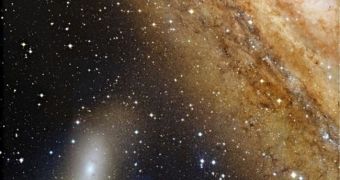Understanding the formation of large, spiral and barrel galaxies is one of the main objectives of astronomy, but this line of research is in fact hindered by observations of dwarf galaxies. The data astronomers observe when studying these objects do not match theoretical predictions.
Until recently, astronomers were convinced that small galaxies which existed in the early Universe – just a couple hundred million years after the Big Bang – were the building blocks of the largest galaxies we see today, including the class the Milky Way belongs to.
Studying these dwarf structures would therefore provide additional data on the generic galactic assembly processes, the theory went on to say. Usually, dwarf galaxies are single nuclei of stellar production, and this helps experts gain an insight into how stars form as well.
The CDM (Lambda Cold Dark Matter) model is generally used to explain the formation of large-scale galaxies. However, it does not function very well when attempting to explain dwarf galaxy.
“If big galaxies are supposed to be formed from numerous mergers of smaller systems, how come the properties of the small galaxies we see today don't match the larger galaxies?” says Eline Tolstoy.
“You may start to wonder if there isn't a fundamental flaw in some aspect of our current understanding of how galaxies form and evolve, and exactly how important mergers are in the history of galaxies,” adds the expert.
Tolstoy holds an appointment as an astrophysicist at the University of Groningen, in the Netherlands, Daily Galaxy reports.
The fact that the CDM model fails to explain dwarf galaxies is a real drawback for astronomers, since it does explain everything else, from the existence and structure of the cosmic microwave background (CMB) and the distribution of chemicals in the Cosmos to the accelerating expansion of the Universe.
However, it could be that these perceived inconsistencies may be a direct result of the relatively large number of uncertainties built into our current interpretation of dwarf galaxy observations. More in-depth studies could be very useful in solving this mystery.
With new data, the current, standard implementation of the CDM model at the small scale could be revamped, and the observations could make more sense afterwards.

 14 DAY TRIAL //
14 DAY TRIAL //